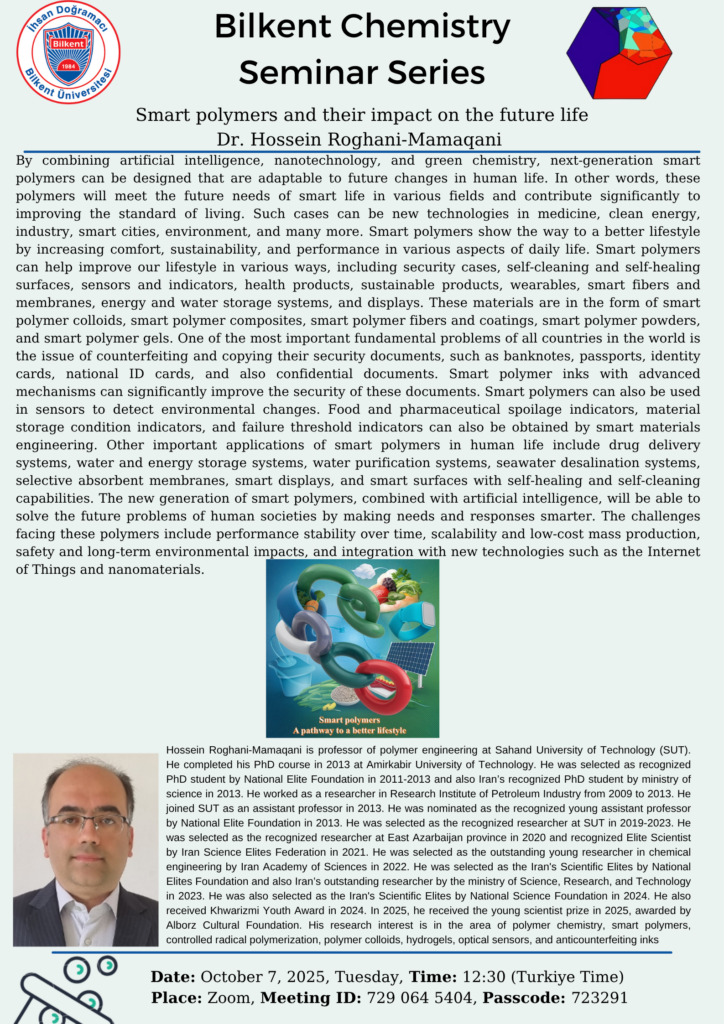Fall ’25 Department Seminars with Dr. Hossein Roghani-Mamagani
Title: Smart polymers and their impact on the future life
Speaker: Dr. Hossein Roghani-Mamagani
Date: 07/10/2025, Tuesday
Time: 12:30 (Turkiye Time)
Place: Zoom
Zoom Meeting ID: 729 064 5404
Zoom Passcode: 723291

Abstract:
By combining artificial intelligence, nanotechnology, and green chemistry, next-generation smart polymers can be designed that are adaptable to future changes in human life. In other words, these polymers will meet the future needs of smart life in various fields and contribute significantly to improving the standard of living. Such cases can be new technologies in medicine, clean energy, industry, smart cities, environment, and many more. Smart polymers show the way to a better lifestyle by increasing comfort, sustainability, and performance in various aspects of daily life. Smart polymers can help improve our lifestyle in various ways, including security cases, self-cleaning and self-healing surfaces, sensors and indicators, health products, sustainable products, wearables, smart fibers and membranes, energy and water storage systems, and displays. These materials are in the form of smart polymer colloids, smart polymer composites, smart polymer fibers and coatings, smart polymer powders, and smart polymer gels. One of the most important fundamental problems of all countries in the world is the issue of counterfeiting and copying their security documents, such as banknotes, passports, identity cards, national ID cards, and also confidential documents. Smart polymer inks with advanced mechanisms can significantly improve the security of these documents. Smart polymers can also be used in sensors to detect environmental changes. Food and pharmaceutical spoilage indicators, material storage condition indicators, and failure threshold indicators can also be obtained by smart materials engineering. Other important applications of smart polymers in human life include drug delivery systems, water and energy storage systems, water purification systems, seawater desalination systems, selective absorbent membranes, smart displays, and smart surfaces with self-healing and self-cleaning capabilities. The new generation of smart polymers, combined with artificial intelligence, will be able to solve the future problems of human societies by making needs and responses smarter. The challenges facing these polymers include performance stability over time, scalability and low-cost mass production, safety and long-term environmental impacts, and integration with new technologies such as the Internet of Things and nanomaterials.
Short Biography of the Speaker:
Hossein Roghani-Mamaqani is professor of polymer engineering at Sahand University of Technology (SUT). He completed his PhD course in 2013 at Amirkabir University of Technology. He was selected as recognized PhD student by National Elite Foundation in 2011-2013 and also Iran’s recognized PhD student by ministry of science in 2013. He worked as a researcher in Research Institute of Petroleum Industry from 2009 to 2013. He joined SUT as an assistant professor in 2013. He was nominated as the recognized young assistant professor by National Elite Foundation in 2013. He was selected as the recognized researcher at SUT in 2019-2023. He was selected as the recognized researcher at East Azarbaijan province in 2020 and recognized Elite Scientist by Iran Science Elites Federation in 2021. He was selected as the outstanding young researcher in chemical engineering by Iran Academy of Sciences in 2022. He was selected as the Iran’s Scientific Elites by National Elites Foundation and also Iran’s outstanding researcher by the ministry of Science, Research, and Technology in 2023. He was also selected as the Iran’s Scientific Elites by National Science Foundation in 2024. He also received Khwarizmi Youth Award in 2024. In 2025, he received the young scientist prize in 2025, awarded by Alborz Cultural Foundation. His research interest is in the area of polymer chemistry, smart polymers, controlled radical polymerization, polymer colloids, hydrogels, optical sensors, and anticounterfeiting inks.